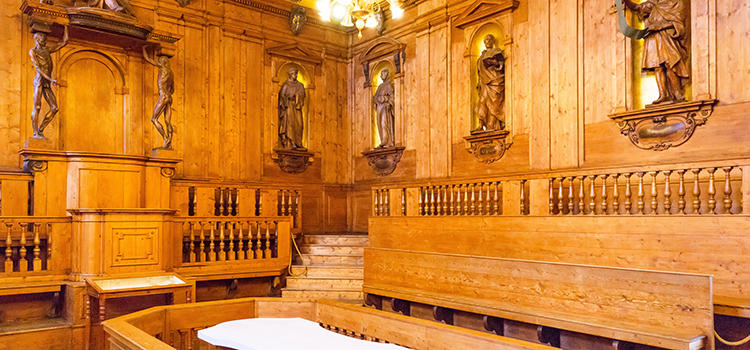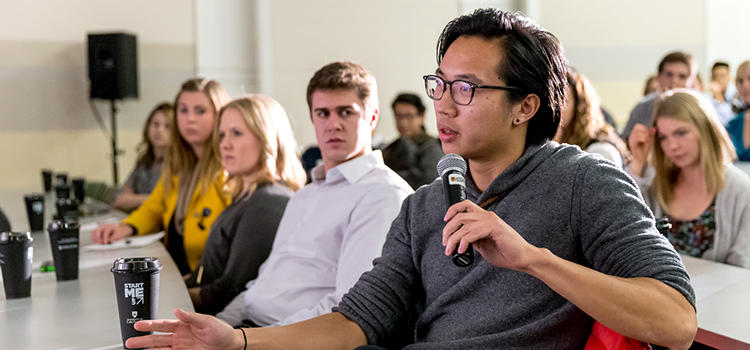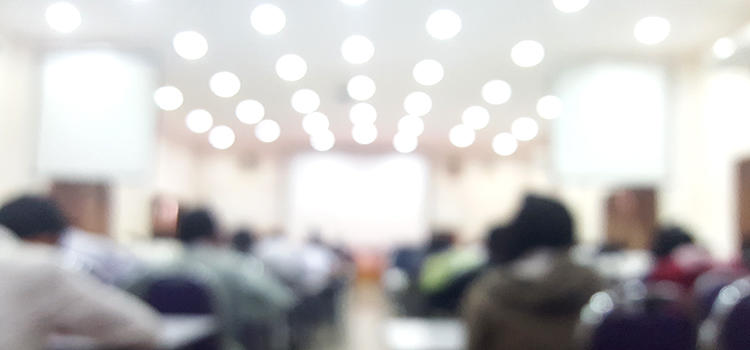
The way students are taught really hasn't changed much in the past 1,000 years.
Nov. 1, 2017
The roots of the modern university can be traced all the way back to the Middle Ages, with the founding of the University of Bologna – recognized as the oldest university in the world – in 1088. It was a far different sort of place than today's institutions of higher learning: guilds or "nations" of students were in charge, hiring and paying instructors and determining course curricula based on what they wanted to learn. Every student's education began with laying the foundation of the seven liberal arts: grammar, logic, rhetoric, arithmetic, geometry, music and astronomy (in that order). From there, students moved on to one of the other faculties of Law, Medicine or Theology to continue their studies.

The way students are taught really hasn't changed much in the past 1,000 years.
Since then, universities have evolved from their early corporate/guild structure to become public institutions, students are no longer in charge, they no longer all complete the same arts program, and the numbers of faculties and specializations have multiplied and expanded as human knowledge has grown. But the way students are taught really hasn't changed much in almost 1,000 years. Instructors stand before rows of seats and deliver lectures while students listen and take notes, and degrees are earned by completing a required set of courses in a predetermined sequence.
That could all be changing as the scholarship of teaching and learning advances, and researchers learn more about how students retain information and what kinds of learning experiences best prepare students for life and the workplace. According to UCalgary experts, the rigid "sage on the stage" model of lecturing is giving way to experiential learning, teaching transferable skills, increased use of technology, open online courses, and allowing students to determine the course of their own learning.

Interdisciplinary approaches are key to tackling the world's biggest challenges.
"Interdisciplinary" is a word heard often on a university campus, referring to combining the methods and insights of different disciplines, and bringing different areas of expertise to bear on a project. It mirrors life outside the academic world, where organizations rely on broad ranges of expertise, cross-functional teams are common, and isolated specialty is rare.
For Jay Cross, director of the new College of Discovery, Creativity and Innovation (CDCI) in UCalgary's Taylor Institute for Teaching and Learning, it's important to teach students to recognize that most challenges in the world are pieces in a larger puzzle, to determine where their perspectives and expertise fit into in the larger system, to refine and iterate ideas for solutions, and to consider different points of view when tackling challenges. According to Cross, the sooner students learn these skills, regardless of their discipline, the better equipped they will be during their academic and professional careers.
"We can't just give them knowledge and then ask them to put it all together in a capstone course at the end."
"System-level thinking, creative thinking, design thinking, collaborative thinking – these are skills we want our graduates to have," says Cross. "Traditionally, some of these skills have been taught as part of capstone courses in fourth year, but they're things that need to be practised again and again throughout the education and the experience of the student. We can't just give them knowledge and then ask them to put it all together in a capstone course at the end."
The CDCI's Global Challenges program aims to foster these skills. Undergraduate students from across campus learn about real problems facing the world – for example, how to feed the expected global population of nine billion by the year 2050 – and come up with solutions. The students start by defining different aspects of the challenge, and where their interests lie. Then they're given the freedom to determine which part of the problem they want to work on.
Instructors rely on systems theory (borrowed from biology and engineering) to help students see how problems and issues are interconnected, and how changing one part affects the other parts of the system. Design thinking (borrowed from the creative and design professions) helps students envision solutions to complex problems and map out steps to put them into action. Together, these are powerful tools to analyze a situation and collaborate on answers. Students use both to map out the scope of the issues, to see how they're all connected, and to work out where they can have an influence based on their own interests.
"If it’s really a global challenge then it’s going to bring together the arts, science, humanities, and all the professional faculties," says Cross. "Each of the disciplines is going to bring a different approach to that challenge. Some would say the solution is to produce more food, some would say it's to waste less, some would say it's about healthier food, some would say it's related to economic policy and access to food. Those are the elements that are all connected in complex ways to a global challenge."
"That diagnostic process, it's not called the same thing as what an artist does with a blank canvas, but in reality it is the same."
According to Cross, the major differences between disciplines are in their knowledge, not in the ways they identify and solve problems – and students can benefit from understanding the common elements between them. "What a medical doctor does is a process, we don’t call it design, we call it diagnostics," he says. "They're faced with a disease, they brainstorm all the things it could possibly be, they do some tests, they refine their hypotheses, they refine their ideas. That diagnostic process, it's not called the same thing as what an artist does with a blank canvas, but in reality it is the same. We're training brains to go through this process, to collect ideas, to work with other people to refine those ideas, to prototype, to get feedback – that's the design process."
"We can capitalize on the ways in which different disciplines look at global challenges," says Leslie Reid, UCalgary's interim Vice Provost (Teaching and Learning), "and bring those together in a learning experience that develops those skills in our students. We used to think interdisciplinary learning would be students from different programs and different backgrounds sitting with each other in the same classroom, all learning the same subject material. Now we see the power of interdisciplinarity as part of an immersive and collaborative learning experience. The point is to expand our students ways of thinking and being in the world."
Learning is much more effective, says Cross, when students can see how the topic relates to the world around them and bring their own perspectives to the table. In the case of the Global Challenges program, "everybody can relate to food and feeding people," he says. "But they're influenced by culture, health, food choices, religion, history. People who come here as immigrants, or maybe from a poor background, likely have a very different attitude toward food waste. When you have something left over, do you throw it out, do you compost it, or do you make soup? That's just looking at it from the local level, never mind the global challenge of feeding nine billion people.
"Students can automatically relate to that theme. You could say, 'well, they don't know enough to solve the problem.' Maybe not, but they know enough to start having conversations, and, with the guidance of the instructor, start moving toward ideas and eventually innovations."
Furthermore, Cross says, when students are given the opportunity to put their learning to work in the community, they see even better how they can make a difference in the world. To make those connections, the Global Challenges program partners students with people and organizations in the community who are related to whatever aspect of the challenge the students are working on, such as grocery store chains or charities, to present their ideas and get feedback. Cross says this approach also makes students more accountable. "The more authentic we can make the experience, the more it creates this inherent motivation for students to want to achieve, to want to grow," he says. "They're not just writing a term paper for class, they're working with people in the real world who care about the outcome of what they're doing."
In the workplace, people are often thrust into unfamiliar situations, such as working on teams or dealing with people with different communication styles and approaches. According to Reid, there's growing research evidence on what makes high-performance teams – and it's important to teach students those skills, rather than expecting them to figure it out once they get into the workforce. "Classroom learning isn’t just about content knowledge anymore," she says, "and whoever makes the fewest errors on a test is the smartest. What's going to set institutions apart is that we're graduating students who have a deep understanding of what they learned, an awareness of how they learn and how to effectively collaborate. We're developing the whole person, intellectually, socially and emotionally. We can put them into new learning experiences, and they can figure out where to go, what questions to ask, how to collaborate and contribute. They see mistakes as growth opportunities, not as a failure of their abilities.”

When students can direct their own learning, they're more engaged, say UCalgary experts.
Part of developing the whole student is giving them the autonomy to choose their own learning path, says Reid. "When students drive the questions or topics they're inquiring about," she says, "they're more motivated and develop the skills of how to learn as well. The process of inquiry is as important as the product of their inquiry."
In the case of the Global Challenges program, Jay Cross says self-direction makes students more invested in learning, because then they're investigating the things they actually want to know. "We're telling them, 'you can do whatever you want, but it's got to be related to this topic and it has to be making a positive contribution, not just describing the challenge,'" he says. "The opportunity to land on the specific topic that is meaningful for them is an incredible motivator. They're not assigned to a narrative that they don't want to be in."
As a result, Cross says, the students all work on vastly different aspects of the challenge, which in turn exposes them even more to other ways of thinking and results in a wide variety of innovations. "Some students were thinking globally, they were thinking future foods, like what do we eat when in the year 2050 perhaps if we didn’t have cows anymore," Cross says. "Others took the approach that we've got to make sure we can feed ourselves locally before we can start thinking about nine billion other people. They worked on innovations related to the local food bank."
"With inquiry-based learning and interdisciplinary learning, the teacher is in a position where they're not always the expert."
Of course, the role of the teacher changes when students are encouraged to explore their own learning path. According to Reid, that change can take some getting used to. "Traditionally the teacher is the one who talks the most in class," says Reid. "The teacher also decides what the class is talking about, how they're talking about it, and when they're talking about it. The decisions and the power are with the teacher. But with inquiry-based learning and interdisciplinary learning, the teacher is in a position where they're not always the expert. They're both teacher and learner, which is a great disruptive thing to experience."
"The situation changes when you're creating opportunities for students to actually practice what they're learning," says Cross. "The role of the instructor is to guide, to facilitate discussion, to create opportunities for students to acquire and practice skills, and to observe that learning is taking place."
While this may seem like a roundabout way of getting students to learn, Cross says the skills they acquire in the process are the key to learning in any situation. "Why are we spending so much time simply transferring information," he says, "as opposed to getting people to develop those thinking skills – critical thinking, system thinking, collaborative thinking. Those are the things that really matter."
Cross recognizes that interdisciplinary thinking is no substitute for specialized training. "Don't get me wrong, we need specialists," he says. "If I'm having brain surgery, I want my brain surgeon to be a really skilled technician. We need engineers who can build bridges that aren't going to fall down. But we also need people who can work across disciplines, who can speak a common language, and who can think at the system level."
In a situation where two people with the same training are competing for the same job, Cross says those thinking skills can give students a potential advantage. "I hear it from employers all the time," he says. "They're looking for transferable skills. Somebody who is trained as a biochemist, but is a system-level thinker, they can apply that to different contexts."
Cross says teaching students how to see systems as a whole can also help develop entrepreneurial thinking – a way of identifying gaps and assessing opportunities. "We're trying to create educational experiences that develop those types of thinking skills," he says. "We're not necessarily turning them into entrepreneurs or businesspeople, but fostering collaboration, creativity, numeracy. Sure some will have applications in the business world, but others will have applications in public policy, in the arts, in healthcare."
What about the teachers themselves? For Reid, it's time for the practice of teaching at the university level to get the attention it deserves. "There's a misconception that great teachers are born, that some people just have this magical skillset," she says. "When in fact, skilled teachers have put a lot of time, effort and intentional practice into their work. In higher education, teaching tends to be a private experience. We don't have a culture of observing each other practise, of collaborating on teaching problems, of learning from each other."
At UCalgary, efforts to change that culture include appointing associate deans for teaching and learning across campus. "It's a resource dedication to leadership positions that support teaching and learning," says Reid. "They provide resources and mentorship and connected with other teaching and learning leaders. Curriculum review and design, assessment and recognition of teaching achievements. I started teaching in a world with no associate deans of teaching and learning, and no vice provost teaching and learning. We talked a lot about teaching and learning and how it needs care and support, and now, with these leaders in place, we can make it happen."

What might a truly interdisciplinary degree look like?
Looking toward the future, Reid sees continued evolution of the practice of teaching. "I think the future is ensuring institutions meaningfully mentor, support, and recognize people's development of their teaching practice over time, and respect the diversity of teaching approaches," she says. "Getting people to think, 'Teaching is a professional practice that I can grow and develop over my career, and these efforts will be recognized as part of my academic work." Reid also sees the future involving reframing students' role in the learning process. “Involving our students as partners in teaching and learning, working together with them to design learning experiences, and sharing the responsibility for learning,“ she says.
As for Cross, he sees the lines between disciplines blurring even further, and students taking more ownership over their educational paths. "What would a university look like moving away from having faculties or schools that are specialized in one thing?" he asks. "We create barriers for being able to take courses across disciplines. We create chains of courses and students have to take this one and that one then that one and that one. If they really want to take that course that’s a 600-level course, they'd better make up their minds two years in advance so they can make sure they've taken all the prerequisites.
"But what do you do if you're interested in physics as well as economics? As it is now you apply to one program or another. Imagine if we were to have a whole university degree where – this is the extreme, I know I'm speaking provocatively here – students don’t enroll in anything other than this innovation course. And students will meet barriers which will then say, “Well, you know nothing about human behavior, go take a psychology course. You don’t know enough about computer coding, go take a computer science course, go take an engineering course." Students will start pulling courses off the shelves like the university is a box store and building the knowledge that they need in order to be more successful in representing their ideas at the end. That would be the extreme model, where the students are defining what they need."
Maybe they had it right in the first place, way back in Bologna in 1088.
Participate in a research study
– – – – –
Dr. James (Jay) Cross, PhD, DVM, is the founding director of the College for Discovery, Creativity and Innovation in UCalgary's Taylor Institute for Teaching and Learning. He is also a professor in the Departments of Comparative Biology & Experimental Medicine, Biochemistry & Molecular Biology, Medical Genetics, and Obstetrics & Gynecology. Jay is an accomplished interdisciplinary researcher, educator, entrepreneur and innovator working in diverse areas such as maternal and child health, and agriculture. Read more about Jay
Dr. Leslie Reid, PhD, is UCalgary's vice-provost for teaching and learning, and a professor in the Department of Geoscience. She also served as associate dean (teaching and learning) in the Faculty of Science from 2012-2017, where she worked to support the creation of educational development programs that help enhance learning and teaching experiences for students and staff. Her scholarly work focuses on STEM teaching and learning and educational development for academic staff.